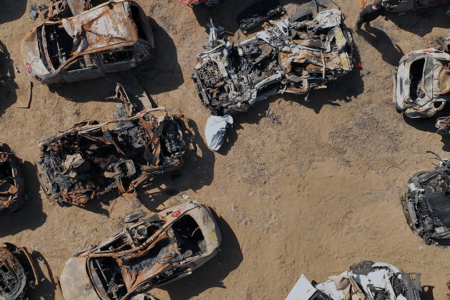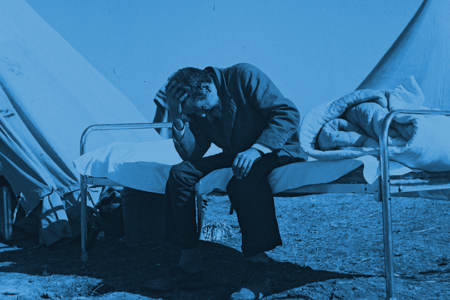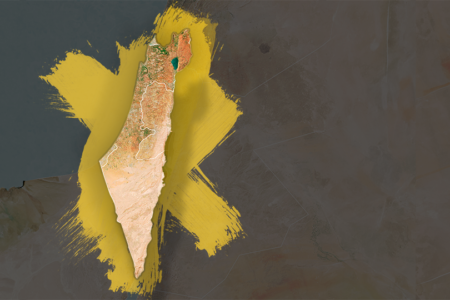A Light For The Temple
Hanukkah, 164 B.C.
The years were written in the lines on the ashen face of the old priest. He stood in the place he and his neighbors usually used for a market. There would be no bartering for vegetables today. The patriarchal figure was the focus of attention for villagers who watched apprehensively. His gaze was frozen to the face of a young Selucid officer standing before him with a sacrificial knife in his outstretched hand. Behind and to the right of the soldier, an altar, erected only that morning, stood in readiness. Nearby, a small detachment of troops surveyed the proceedings with casual interest. One of them was more attentive to the pig tied by a short cord than to the principals in the drama. Silence, unbroken except for the shuffling of a soldier’s feet or the low grunts of the animal, seemed to hang like a weight in the sultry afternoon air.
Old Mattathias’ eyes were on Apelles, official emissary of the detested Selucid ruler, Antiochus IV. While he stood in the center of the little Judean village of Modin, the priest’s mind was in Jerusalem, seventeen miles southeast of where he was standing at the moment. Israel had fallen on desperate times. A year ago, the Temple had been looted, while the Holy City was being ravished and partially burned by the Selucids. Many of the Jerusalemites he had assisted in worship at the Temple were in far away lands laboring under the rigors of slavery. Months later, he and fellow priests had lived through the nightmare of the imperial visit that threatened a death knell for Judaism. Antiochus came to Jerusalem with two deadly aims in mind. First, he would dismantle the religion of the Jews. Accordingly, his first point of attack was the Jewish Temple on Mount Moriah. He battered his way inside, tore away the curtain dividing the holy places, ripped the adorning metals from the walls and destroyed the gates and doors to the buildings. As if his entry into the Holy of Holies was not enough, he summoned soldiers who committed lurid acts of immorality within the sacred confines of the sanctuary. His consummate act of infidelity took place with the profanation of the great altar by the slaughter of a common swine. The altar of Jehovah, from which the smoke of countless clean offerings had ascended, was now smeared with the gore and grease of pigs.
Antiochus’ next act, and the one to which all else had been directed, was to declare the full establishment of Hellenism as the absolute standard of the land. The monarch had made similar declarations to every subject country in his domain. His purpose was to strengthen and stabilize his position before the rising power of Rome and other would-be predators. To other pagan people, the business of paying homage to a few more gods meant very little; to the Jews, it was devastating. Hellenism, if established, meant assimilation into the culture of the Greeks. Attendant to this, of course, was the worship of pagan deities and intercourse with customs pious Jews found abhorrently immoral. As a catalyst for his sweeping revolution, Antiochus chose to declare himself divine. His title was Theos Epiphanes, “the Manifest God”. He would become the central object of worship for his hapless subjects. Consequently, he erected, upon the altar at the Temple, one dedicated to the Greek god Olympian Zeus. Above his altar, he hung a likeness of the god for all to see – its facial features were his own. From now on, he decreed, Jews would direct worship to their sovereign who reigned in Antioch, not the God they claimed reposed in some far-off heaven. Those who chose to refuse the order were to be summarily executed.
His heart immobilized with grief, the elderly Mattathias, along with fellow priestly descendants of Aaron, left the City of David to seek a quiet sanctuary from which to raise their laments. He had come only a few miles, but the Jerusalem he had known and loved was light years away. He would, however, find little respite in Modin. The decree was binding throughout Judea. Soon Selucid troops were fanning out from their fortress in Jerusalem under orders to force the people to embrace Hellenism. Their task was to set up altars and impress prominent Jews to sacrifice pigs. This was to be followed by a show of submission: Each villager present was to eat a portion of the meat of the animal. In Modin, Mattathias was selected by Apelles to make the offering and be the first to taste the flesh. If he would cooperate, the Selucid reasoned, others would certainly follow the example of their respected neighbor. Mattathias coldly refused the order, and stood before Apelles waiting to be struck down.
Suddenly, the old man was shaken from his thoughts by movement in the crowd. A man from the village was advancing toward the officer. “I will make the sacrifice on behalf of our people,” he said softly. With that he took the knife and walked to the altar. A soldier raised the struggling pig and placed it before the man. As he began to raise the knife, an outraged Mattathias leaped on him, wrested the knife from his grasp and plunged it into the villager. Before the astonished Apelles could react, he too, was dealt a death blow. Emboldened by his act, the priest’s five sons and other men of the town quickly dispatched the remaining soldiers. It was quiet in Modin once more.
Now there was no course open but to strap on the sword and resist to the death – there was no other way. One of Mattathias’ sons, Judas Maccabeus (the hammer), was chosen to lead the resistance.
The sons of Mattathias would prove to be intrepid warriors. One who studies their exploits will soon agree that these were men enabled by God to rise to what seemed to be an impossible assignment. These farmers stood with their meager assortment of sticks and sickles before one of the premier fighting forces in the known world. Yet, one by one, the most notable commanders of Selucian phalanx fell before them. Apollonius, Seron, Nicanor, Gorgias and Antiochus’ viceroy, Lysias, joined the succession of professionals who were bewildered at being routed by what they felt was a ragtag band of upstarts.
Antiochus, crazed with anger over his reverses in Judea, had sent Lysias into battle with a chilling directive. He was to “uproot and destroy the strength of Israel and the remnant of Jerusalem, to blot out all memory of them from the place, to settle strangers in all their territories, and to allot their land to the settlers” (I Maccabees 3:35, 36). He was, fortunately, little more successful than his predecessors. It was not long thereafter that Antiochus Epiphanes, the one who called himself “the Manifest God”, was dead and removed from the scene; Israel still lived.
The contribution of the heroic sons of Mattathias should be remembered with deep thanksgiving – not only by Jews, but by Christians as well. They stood against the prime evils Satan has recurrently sent upon the Chosen People: genocide, and the attempt to destroy their God-instituted religion. Antiochus set out to do what will be tried again by the coming antichrist: stop God short of accomplishing all He has purposed to do through and for Israel. The dimensions of the infamous designs of Antiochus are put in concise perspective by a prominent Jewish historian, who observed that had he succeeded, he “might well have stifled the Jewish religion in Judea, and there would have been no dramatic crucifixion of a Jew in Jerusalem two hundred years later!”
Hanukkah, 25 Kislev, 164 B.C.
Even before the issue was decided, Judas determined to right the wrongs in Jerusalem. He and his cohorts moved on the city and secured the Temple Mount. As they walked through the courts of the sanctuary, these stalwart fighting men were moved to tears by what they saw. The building was in disrepair, weeds had infested the courts and grew in ragged thickets. A polluted altar stood silent and cold beneath the remains of the “abomination” placed there by their tormentor.
They were soon about the work of restoring and cleansing the sanctuary in preparation for a new dedication of the Temple. Upon completion of their task, the people were called together for the joyful ceremony. It was a day of grand celebration. “They arose early and offered sacrifice according to the Law upon the newly made altar of burnt offering. On the anniversary of the day when the heathen had profaned it, on that very day, it was reconsecrated, with hymns and thanksgiving, to the music of harps and lutes and cymbals. All the people prostrated themselves and uttered praises to Heaven that their cause had prospered” (I Maccabees 4:52-55).
The Temple was dedicated on the 25th day of Kislev (Jewish lunar reckoning). Kislev is roughly equivalent to December on our solar calendars. This was exactly three years to the day from the time it had been desecrated by Antiochus.
Thus, Hanukkah, which in Hebrew means “dedication”, was born. The feast, also known as the Feast of Lights, was celebrated over a period of eight days. As the name implies, lights played, and still do today, a prominent part in the festival. This was, in all likelihood, because the seven-branched menorah sent forth a new light in the Holy Place. Of no less significance was the fact that the sky above the Temple Mount was aglow from the sacrificial fires upon the great altar.
The lights were burning in Israel – Jews of all centuries to follow would commemorate the event. To this end, eight-branched Hanukkah lamps or candelabra came into use. One candle is lit successively for each day of the feast. By the eighth day, the room is filled with the warm illumination of all branches of the candelabra. In ancient days, many families would light one candle for each member of the household. By the last day of the celebration the light had been multiplied many times over.
At the Hanukkah season Jerusalem was adorned by lights which shone with spectacular brilliance from the Temple Mount and windows of houses throughout the city. They sent forth thousands of testimonial rays which came together in one flame of affirmation of the faithfulness of the God who had preserved His people.
These events transpired during the intertestamental period. This was a span of four hundred “silent years” which lay between events recorded in the Old and New Testaments. It was a time when there was no voice of the prophet in the land; no divinely-appointed king on David’s throne. There were, however, prophetic overtones set in motion by the priestly followers of the Maccabees during the cleansing of the Temple. The old altar, which had been profaned, was disassembled. This brought up a serious question: What should be done with those sacred stones? After some deliberation, they “laid up the stones in the mountain of the temple in a convenient place until there should come a prophet to shew what should be done with them” (I Maccabees 4:46). Nearly two hundred years later, they were still waiting.
Jesus At The Feast
Jesus of Nazareth has an intriguing relationship to the Feast of Lights. As we shall see, this association was not coincidental. The traditional day of His birth, December 25th, corresponds with the day the lights began to burn again in Israel. While this date is the subject of scholarly discussion, the symbolism demonstrated in the feast and his statements, made in Jerusalem when He attended Hanukkah, stand above questioning.
Jesus stepped into the throng of pilgrims moving up to Jerusalem for the annual celebration. As they approached the city, He could see festive lights from Hanukkah lamps dancing in every window. Across the Kidron Valley, the Temple Mount was alight with a brilliance that called the people to remember the courageous deeds of the Maccabeans, and their struggle to preserve the light for coming generations. On this day, that promised Greater Light, had come to Israel. The long-awaited Prophet was among the Chosen People.
Over thirty years before this visit, Jehovah had hung a blazing light in a winter sky to guide men to the side of the infant who was born in a stable at Bethlehem. During the years of His ministry before the Jewish people the light from His life glowed ever brighter. As the lighting of successive Hanukkah candles brought greater brilliance, so the progressive revelation of Jesus’ deity served to magnify Him as the Anointed One. Every miracle He performed, every word and line that He taught, every pronouncement He made added to the brightness of the light He brought into a darkened world.
Jesus would return to Jerusalem in a few months to attend one more feast – Passover. There, He, himself, would become the central figure as “the Lamb of God, who taketh away the sin of the world”. Before this climactic revelation, He made His way to Jerusalem to bring a declaration – one which was in absolute harmony with the message of the season. One can only agree that this moment was fixed by divine resolve in the council chambers of eternity. With the Hanukkah lights flickering across His countenance, Jesus answered the solemn query of the elders of Israel: “How long dost thou make us to doubt? If thou be the Christ, tell us plainly.” His reply terminated in the greatest shaft of divine light ever to penetrate man’s sin-benighted habitation: “I and my father are one,” He stated in direct affirmation that He was God’s Anointed One. But not simply a human messiah empowered by Jehovah, Jesus was the God-Man; Jehovah in their midst – God come down to earth to answer man’s need.
With this declaration, Hanukkah lights and the illumination from the Star of Bethlehem fused. The Maccabees had kept the fire of hope burning on the altar – hope that one day the atonement (covering) offered by animal sacrifices would give way to full propitiation (reconciliation). Jesus exhibited the fullness of His provision in the words which preceded His declaration. “And I give unto them (believers) eternal life; and they shall never perish, neither shall any man pluck them out of my hand. My father, which gave them me, is greater than all; and no man is able to pluck them out of my Father’s hand” (Jn. 10:28, 29). All of the shadows falling across man’s journey toward the grave and beyond were dispelled. Antiochus had attempted to pluck the nation from the protecting hand of God, and found he had undertaken an impossible task. Jesus was now telling them that He and His father would forever secure, beyond the grasp of any opposing force, all who would place their faith in Him. In Christ, the believer would find the assurance of life, security and divine protection. All of this was offered in an attainable formula: as a gift, through believing on His finished work.
The priests now had available an answer for their dilemma over those stones from the old altar. True, they could not be used to bear sacrificial fires again – neither need they. Let them be mingled with the stones of the altar in use and raised in a great memorial to the faithfulness of Jehovah. Let those polluted stones represent Israel’s agony, while the newer ones stand for her expectation. An expectation that was soon to be realized. Before many days had passed, a new altar would be raised in Jerusalem. During the observance of their next feast that last altar would be built. Not, this time, of unhewn stones, but rather in the wood of a Roman cross. It would, indeed, be the final altar in God’s program of substitutionary redemption. One time more, it could rightly be said, “. . . bind the sacrifice with cords, even unto the horns of the altar.” Forever thereafter the words of Psalm 118:27, which immediately precede that statement, would stand before Israel and all men: “God is the Lord, which hath shown us light. . . .”
Jews and Christians give and receive gifts during Hanukkah and Christmas celebrations. Jesus Christ, God’s supreme gift to both Jew and Gentile is offered to all who will accept it – He is yours to receive.






